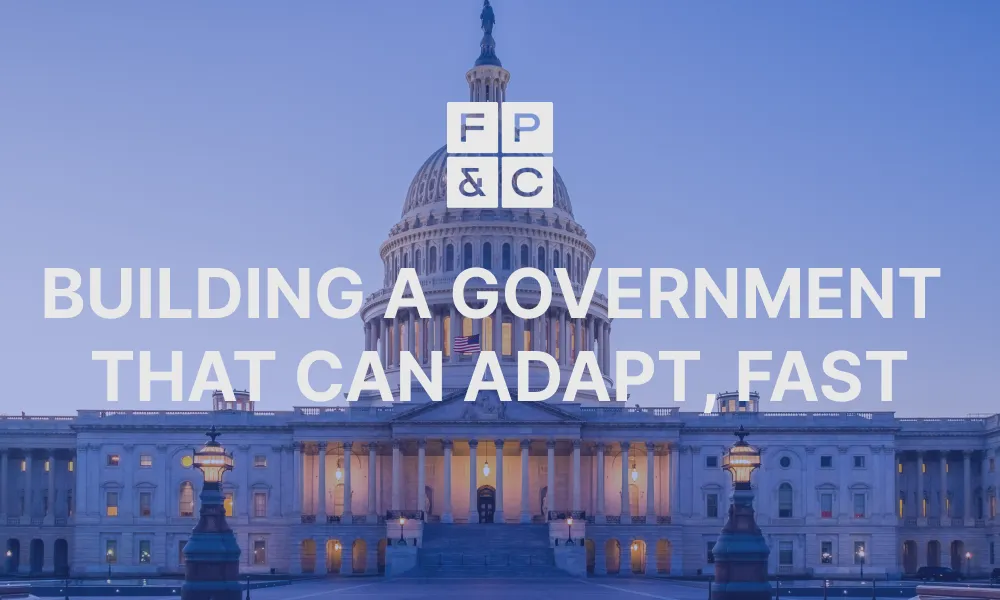
Building a Federal Government That Can Adapt, Fast
Today’s federal missions are more complex and fast-moving than ever. Agencies are balancing cyber threats, public health emergencies, and citizen expectations that rival those of the private sector, all while working within legacy structures. We sat down with Charles Hargett, federal procurement expert and President and CEO of First Principles & Concepts (FP&C), to discuss why the federal government needs more adaptive operating models, how flexibility and modularity can unlock transformation, and what leaders can do to begin the shift.
Q&A with Charles Hargett, President & CEO, FP&C
Question: What do we mean by an “adaptive operating model” in the federal context?
Answer: Think of an adaptive operating model as the government’s way of staying nimble. Instead of clinging to rigid hierarchies and one-size-fits-all processes, agencies break their work into modular pieces: teams, tools, and budgets that can be reassembled on the fly. When the mission changes, the model shifts with it, so you’re constantly optimizing for real outcomes rather than just ticking boxes.
Question: Why is flexibility so critical for government today?
Answer: Flexibility matters because today’s world doesn’t wait for slow-moving bureaucracy. Natural disasters, cyber threats, and public health emergencies don’t follow fiscal calendars; they erupt at any moment. At the same time, technology is sprinting ahead: artificial intelligence, blockchain, and new cloud services appear almost overnight, yet legacy procurement can take years. And let’s not forget citizens: they expect the same smooth, consumer-grade digital experiences from their government that they get in their personal lives. If we can’t pivot quickly, we can’t meet those expectations.
Question: How does modularity empower agencies?
Answer: Modularity is a bit like playing with LEGO® blocks: instead of rebuilding the entire castle when you want to add a new tower, you just swap out or attach one block. Agencies can update a single function, like identity management or data analytics, without tearing everything down. That also means funding flows more sensibly: if a high-priority project emerges mid-year, you can reallocate budget to it without wrestling over the entire appropriation. Plus, once you build a capability, you can reuse it elsewhere, saving time and money.
Question: Are adaptive operating models scalable across large, complex agencies?
Answer: Absolutely. In fact, the bigger and more complex an agency is, the more critical adaptability becomes. Adaptive models allow leaders to set clear mission outcomes at the top level while empowering decentralized teams to experiment, iterate, and adjust. With the right governance guardrails, you create a balance: strategic alignment without micromanaging execution.
Question: What real-world examples showcase adaptive models in action?
Answer: You don’t have to look far to find success stories. FEMA released its National Risk Index as a bare-bones prototype, then improved it each month based on user feedback. GSA’s 18F team spins up small, cross-agency squads to tackle everything from pandemic response tools to cloud migrations, standing them down when the job’s done. And during COVID, the VA stood up a telehealth platform almost overnight by tapping into modular contracts and pre-packaged data-center “in a box” services. Those early wins helped fuel broader transformation.
Question: What common barriers slow adoption?
Answer: The biggest hurdles are cultural and procedural. Traditional procurement rules still essentially ask for every detail up front, which conflicts with an iterative approach. Culturally, many agencies are built on top-down directives, so empowering small, autonomous teams feels risky. And budget cycles? Annual appropriations don’t easily support shifting priorities halfway through the year. Overcoming those obstacles takes leadership buy-in, process reform, and a willingness to experiment.
Question: How can agencies begin shifting to adaptive models?
Answer: Start small. Kick off “micro-sprints” by funding a tiny team for six to eight weeks to solve a narrowly defined problem—say, digital credentialing or workflow automation. Next, tweak contracts so they’re modular: task orders for specific capabilities, incentives tied to usable outcomes, and the freedom to pivot. Invest in shared platforms—cloud services, identity hubs, analytics toolkits—that any agency can tap into. And finally, nurture adaptive leaders: train managers to plan by outcomes, trust decentralized decision-making, and celebrate teams that deliver value fast.
Question: What does success look like in an adaptive model?
Answer: Success isn’t just faster delivery; it’s delivering the right outcomes. Adaptive operating models can help the government respond to emerging risks in days, not months. They allow agencies to redirect resources in real time, improve transparency with stakeholders, and deliver citizen-facing services that feel modern and intuitive.
Question: What’s the bottom line?
Answer: At the end of the day, our challenges move faster than ever. To keep pace, the federal government needs to embrace operating models built for change. By prioritizing flexibility, modularity, and responsiveness, agencies can deliver better results more quickly, make smarter use of taxpayer dollars, and stay ahead of whatever comes next.
Interested in making your agency more adaptive?
Let’s talk about how FP&C can help you design and implement a model built for today’s fast-moving mission.
